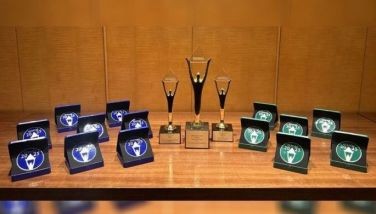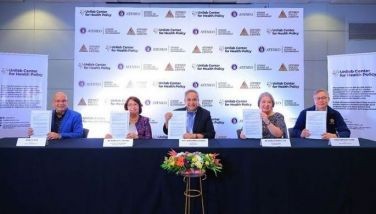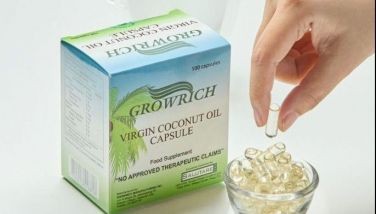Auto parts from abaca, anyone?
January 29, 2007 | 12:00am
A Bicol lawmaker says abaca fiber — the region’s principal export — can be blended and made a composite material for spare parts and accessories for motor vehicles.
According to Camarines Sur Rep. Luis Villafuerte, abaca fiber can be used as a substitute composite material for fiberglass, which is used for making quality car interior and exterior components.
In a speech, Villafuerte told the Chamber of Automotive Manufacturers of the Philippines Inc. and the Motor Vehicle Parts Manufacturers Association of the Philippines Inc. that high oil prices are driving car makers to look for lighter designs and fuel efficient accessories.
"The use of abaca fiber as a substitute for fiberglass in composites for the production of car interior and exterior components makes a lot of sense nowadays," he said.
Villafuerte urged local car manufacturers to emulate Europe’s Daimler Chrysler AG which has integrated abaca fiber in its parts and accessories.
The car makers should "give more meaning to their pledge to use more locally-sourced raw materials," he said.
"For starters, we reckon local car makers can readily substitute their imported seat cover fabrics, interior carpeting and even dashboards with material made of, or blended with abaca fiber," Villafuerte pointed out.
Daimler Chrysler’s Mercedes Car Group began using abaca fiber for the outer cover of the spare wheel compartment of its top-of-the-line passenger units several years ago.
The world famous automotive firm has since developed other uses for the fiber.
Villafuerte said the country’s abaca industry is "a sunrise enterprise," with vast potentials for commercial and industrial applications. He said the use of the plant’s fiber is still largely untapped.
"Even if we exported all of our abaca fiber output today, this would cover just a little over 10 percent of the estimated 600,000-metric ton annual global demand," he said.
Some 136,000 hectares nationwide are now planted to abaca, according to the Fiber Industry Development Authority (FIDA). More than 82,000 Filipino farmers subsist on abaca production.
Annually, these farmers produce some 70,000 metric tons of fiber, of which about 25 percent is exported.
Global demand for abaca has increased the local buying price of the plant’s fiber by 50 percent over the last five years, from P30 to P45 per kilo.
Villafuerte has urged FIDA to draw up "an aggressive and determined plan" to advance the abaca trade, which he said "faces an extremely bright future."
"FIDA has to produce a broad development strategy that Congress can then consciously support with ample funding," Villafuerte said.
"The blueprint should include sound and actionable recommendations to remove industry snags and deliberate measures to propel growth in an orderly manner," he said.
Abaca is a species of banana native to the Philippines and cultivated in the Bicol region, Eastern Visayas and Mindanao.
The plant is harvested mainly for its large leaves and stems that produce the world’s sturdiest natural fiber, called Manila hemp.
Used primarily to make twines, ropes and carpets, abaca fiber also has multiple applications as raw material for various functional and decorative products. The fiber is used in clothing material and handicraft like bags and baskets.
The pulp is processed into tea bags, coffee filter, vacuum cleaner bags, currency notes and other specialty paper.
Abaca-based furniture and fixtures – from settees to lounge chairs, from dividers to coffee tables, and from sofas to loveseats – are also widely recognized for their elegance in Europe and North America.
Studies have also identified abaca enzymes for use in high-value cosmetic and dietary products.
The Department of Agriculture recently approved P20.7 million in fresh funding for applied biotechnology research projects to boost abaca production through genetically modified, disease-resistant varieties.
According to Camarines Sur Rep. Luis Villafuerte, abaca fiber can be used as a substitute composite material for fiberglass, which is used for making quality car interior and exterior components.
In a speech, Villafuerte told the Chamber of Automotive Manufacturers of the Philippines Inc. and the Motor Vehicle Parts Manufacturers Association of the Philippines Inc. that high oil prices are driving car makers to look for lighter designs and fuel efficient accessories.
"The use of abaca fiber as a substitute for fiberglass in composites for the production of car interior and exterior components makes a lot of sense nowadays," he said.
Villafuerte urged local car manufacturers to emulate Europe’s Daimler Chrysler AG which has integrated abaca fiber in its parts and accessories.
The car makers should "give more meaning to their pledge to use more locally-sourced raw materials," he said.
"For starters, we reckon local car makers can readily substitute their imported seat cover fabrics, interior carpeting and even dashboards with material made of, or blended with abaca fiber," Villafuerte pointed out.
Daimler Chrysler’s Mercedes Car Group began using abaca fiber for the outer cover of the spare wheel compartment of its top-of-the-line passenger units several years ago.
The world famous automotive firm has since developed other uses for the fiber.
Villafuerte said the country’s abaca industry is "a sunrise enterprise," with vast potentials for commercial and industrial applications. He said the use of the plant’s fiber is still largely untapped.
"Even if we exported all of our abaca fiber output today, this would cover just a little over 10 percent of the estimated 600,000-metric ton annual global demand," he said.
Some 136,000 hectares nationwide are now planted to abaca, according to the Fiber Industry Development Authority (FIDA). More than 82,000 Filipino farmers subsist on abaca production.
Annually, these farmers produce some 70,000 metric tons of fiber, of which about 25 percent is exported.
Global demand for abaca has increased the local buying price of the plant’s fiber by 50 percent over the last five years, from P30 to P45 per kilo.
Villafuerte has urged FIDA to draw up "an aggressive and determined plan" to advance the abaca trade, which he said "faces an extremely bright future."
"FIDA has to produce a broad development strategy that Congress can then consciously support with ample funding," Villafuerte said.
"The blueprint should include sound and actionable recommendations to remove industry snags and deliberate measures to propel growth in an orderly manner," he said.
Abaca is a species of banana native to the Philippines and cultivated in the Bicol region, Eastern Visayas and Mindanao.
The plant is harvested mainly for its large leaves and stems that produce the world’s sturdiest natural fiber, called Manila hemp.
Used primarily to make twines, ropes and carpets, abaca fiber also has multiple applications as raw material for various functional and decorative products. The fiber is used in clothing material and handicraft like bags and baskets.
The pulp is processed into tea bags, coffee filter, vacuum cleaner bags, currency notes and other specialty paper.
Abaca-based furniture and fixtures – from settees to lounge chairs, from dividers to coffee tables, and from sofas to loveseats – are also widely recognized for their elegance in Europe and North America.
Studies have also identified abaca enzymes for use in high-value cosmetic and dietary products.
The Department of Agriculture recently approved P20.7 million in fresh funding for applied biotechnology research projects to boost abaca production through genetically modified, disease-resistant varieties.
BrandSpace Articles
<
>
- Latest
- Trending
Trending
Latest




























